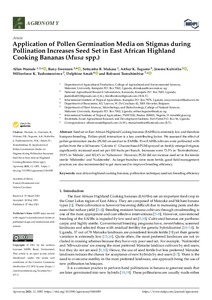| dc.contributor.author | Waniale, A. |
| dc.contributor.author | Swennen, R. |
| dc.contributor.author | Mukasa, S. |
| dc.contributor.author | Tugume, A.K. |
| dc.contributor.author | Kubiriba, J. |
| dc.contributor.author | Tushemereirwe, W.K. |
| dc.contributor.author | Amah, D. |
| dc.contributor.author | Tumuhimbise, R. |
| dc.date.accessioned | 2021-06-21T12:19:42Z |
| dc.date.available | 2021-06-21T12:19:42Z |
| dc.date.issued | 2021 |
| dc.identifier.citation | Waniale, A., Swennen, R., Mukasa, S.B., Tugume, A.K., Kubiriba, J., Tushemereirwe, W.K., ... & Tumuhimbise, R. (2021). Application of pollen germination media on stigmas during pollination increases seed set in east African highland cooking bananas (Musa spp.). Agronomy, 11(6), 1085: 1-9. |
| dc.identifier.issn | 2073-4395 |
| dc.identifier.uri | https://hdl.handle.net/20.500.12478/7139 |
| dc.description.abstract | Seed set in East African Highland Cooking bananas (EAHBs) is extremely low and therefore hampers breeding. Pollen–pistil interaction is a key contributing factor. We assessed the effect of pollen germination media (PGM) on seed set in EAHBs. Five EAHB cultivars were pollinated with pollen from the wild banana ‘Calcutta 4’. Glucose-based PGM sprayed on freshly emerged stigmas significantly increased seed set per 100 fruits per bunch. Increases were 73.5% in ‘Enzirabahima’, 39.9% in ‘Mshale’, and 302.4% in ‘Nshonowa’. However, PGM did not increase seed set in the female sterile ‘Mlelembo’ and ‘Nakitembe’. As larger bunches were more fertile, good field management practices are also recommended to get more seed to improve breeding efficiency. |
| dc.description.sponsorship | Bill & Melinda Gates Foundation |
| dc.format.extent | 1-9 |
| dc.language.iso | en |
| dc.subject | Bananas |
| dc.subject | Musa |
| dc.subject | Pollination |
| dc.subject | Seedlings |
| dc.subject | Breeding |
| dc.subject | Food Crops |
| dc.subject | Uganda |
| dc.subject | Cooking Bananas |
| dc.subject | Plantains |
| dc.title | Application of pollen germination media on stigmas during pollination increases seed set in east African highland cooking bananas (Musa spp.) |
| dc.type | Journal Article |
| cg.contributor.crp | Roots, Tubers and Bananas |
| cg.contributor.affiliation | Makerere University |
| cg.contributor.affiliation | National Agricultural Research Laboratories, Uganda |
| cg.contributor.affiliation | International Institute of Tropical Agriculture |
| cg.contributor.affiliation | Katholieke Universiteit, Leuven |
| cg.contributor.affiliation | Rwebitaba Zonal Agricultural Research and Development Institute, Uganda |
| cg.coverage.region | Africa |
| cg.coverage.region | East Africa |
| cg.coverage.country | Uganda |
| cg.coverage.hub | Eastern Africa Hub |
| cg.researchtheme | Biotech and Plant Breeding |
| cg.identifier.bibtexciteid | WANIALE:2021a |
| cg.isijournal | ISI Journal |
| cg.authorship.types | CGIAR and developing country institute |
| cg.iitasubject | Agronomy |
| cg.iitasubject | Banana |
| cg.iitasubject | Food Security |
| cg.iitasubject | Plant Breeding |
| cg.iitasubject | Plant Production |
| cg.iitasubject | Plantain |
| cg.journal | Agronomy |
| cg.notes | Open Access Journal; Published online: 27 May 2021 |
| cg.accessibilitystatus | Open Access |
| cg.reviewstatus | Internal Review |
| cg.usagerightslicense | Creative Commons Attribution 4.0 (CC BY 0.0) |
| cg.targetaudience | Scientists |
| cg.identifier.doi | https://dx.doi.org/10.3390/agronomy11061085 |
| cg.iitaauthor.identifier | Rony Swennen: 0000-0002-5258-9043 |
| cg.iitaauthor.identifier | Delphine Amah: 0000-0002-5706-8773 |
| cg.futureupdate.required | No |
| cg.identifier.issue | 6: 1085 |
| cg.identifier.volume | 11 |
| cg.contributor.acknowledgements | On-going studies on increasing seed set in banana (Matooke and Mchare) are part of the PhD study of the first author. We recognize the Breeding Better Banana project which funded the studies on banana floral biology. The authors also thank all donors who supported this work through their contributions to the CGIAR Fund (http://www.cgiar.org/funders/, accessed on 14 August 2020), and in particular to the CGIAR Research Program for Roots, Tubers, and Bananas (CRP-RTB). |

